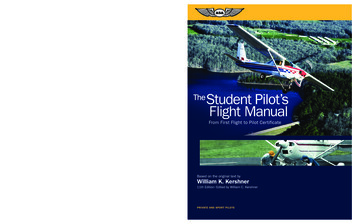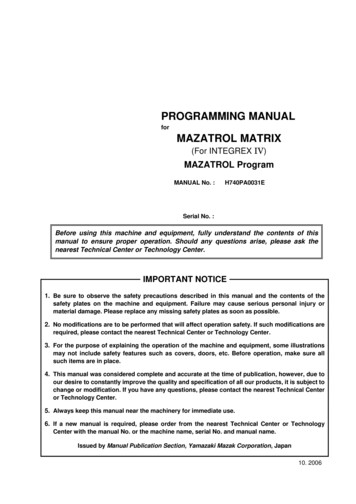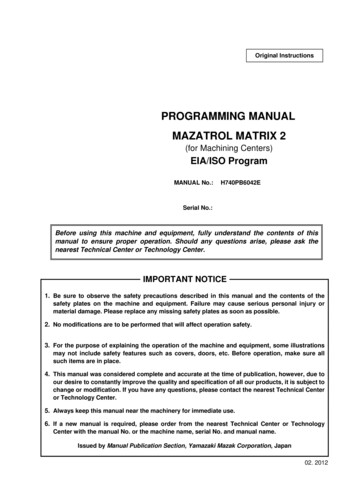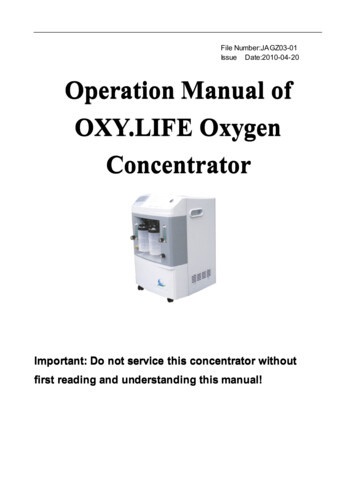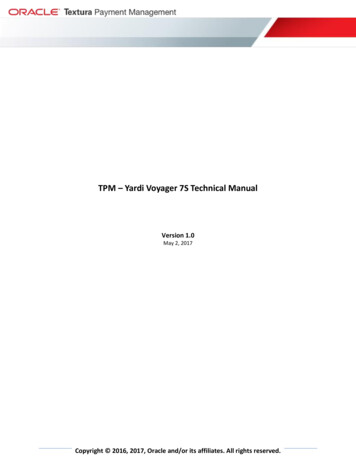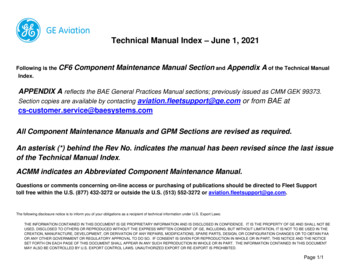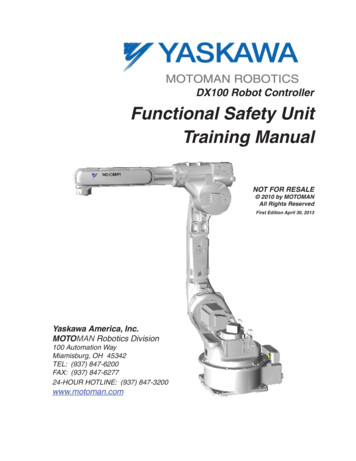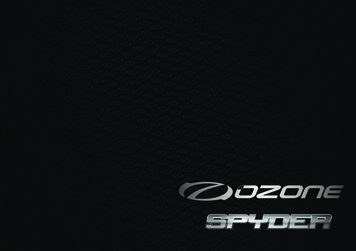
Transcription
CONTENTSPilots Manual (En)Manual2 18Materials 19Line Diagram 20Riser Diagram/Lengths 21Technical Specificationsv1.1 Feb 201621OZONE GLIDERS 1258 Route de Grasse, 06620, Le Bar sur Loup, France
All our research and development is concentrated on creating the best handling characteristics possible with optimum security. Confidence and belief in your paraglider is a far greater asset than any small gains in performance - ask any of the Ozonepilots on your local sites, or those who have taken our gliders on ground-breaking adventures and stood on podiums around theworld.Our development team is based in the south of France. This area, which includes the sites of Gourdon, Monaco and Lachens,guarantees us more than 300 flyable days per year. This is a great asset in the development of the Ozone range.As pilots we fully understand just how big an investment a new paraglider is. We know that quality and value for money areessential considerations when choosing your new paraglider; so to keep costs low and quality high we now build all our wingsin our own production plant. This way we can guarantee that all our paragliders meet the same high standards that we expectourselves.This manual will help you get the most out of your Spyder. It details information about the Spyder’s design, tips and advice onhow best to use it and how to care for it to ensure it has a long life and retains a high resale value.If you need any further information about Ozone, the Spyder, or any of our products please check www.flyozone.com or contactyour local dealer, school or any of us here at Ozone.It is essential that you read this manual before flying your Spyder for the first time.Please ensure that this manual is passed on to the new owner if you ever resell this paraglider.Ozone’s web site, www.flyozone.com carries up-to-date information, including any safety issues or issues specific to your Spyder. Please check it regularly.Safe FlyingAll the team @ Ozone3ENGLISHThank you for choosing to fly an Ozone Spyder.As a team of flying enthusiasts and adventurers, Ozone’s mission is to build sweet handling, agile paragliders which produce ‘cutting edge’ performance, whilst still keeping you safe in rough air.
TEAM OZONEEveryone at Ozone continues to be driven by ourpassion for flying, our love of adventure and ourquest to see Ozone’s paraglider development create better, safer and more versatile paragliders.Flying an Ozone paraglider is undertaken with the full knowledge that paramotoring involves risks.As the owner of an Ozone paraglider you take exclusive responsibility for allrisks associated with its use. Inappropriate use and or abuse of your equipment will increase these risks.Paragliding design is led by the ever thoughtful David Dagault; Davhas a wealth of experience both in competition, adventure flyingand paraglider design. Also on the design team are Russell Ogden,Luc Armant and Fred Pieri.Ozone paragliders are only suitable for qualified pilots or those under instruction. This manual does not replace proper instruction. Make sure youseek professional tuition and learn with a reputable school.Russ is a top competition pilot and ex paragliding instructor, he canusually be found putting Dav’s latest creation through a series oftest manoeuvres. Luc, a dedicated XC addict has a background innaval architecture. He brings a wealth of knowledge and ideas tothe design team and works closely with Dav in the design process. Fred is the latest addition to the team. He is a mathematian,mechanical engineer and vol Biv specialist and works closely withDav and Luc.Use only certified paragliders, harnesses with protector and reserve parachutes that are free from modification, and use them only within their certified weight ranges. Please remember that flying a glider outside its certifiedconfiguration may jeopardise any insurance (e.g. liability, life etc) you have.All pilots should have the appropriate level of license for their respectivecountry and third party insurance.Make sure that you are physically and mentally healthy before flying.Choose the correct wing, harness and conditions for your level of experience.Pay special attention to the terrain you will be flying and the weather conditions before you launch. If you are unsure do not fly, and always add a largesafety margin to all your decisions.Former female World champion, Emilia Plak manages the paramotor department. She is helped by Mathieu Rouanet and Alex Mateos, two of the finest pilots in the world holding World, Europeanand French Paramotoring champion titles amongst them. They bothoffer valuable advice and feedback throughout the developmentprocess, helping to produce the perfect blend of safety, speed andperformance.Avoid flying your glider in rain, snow, strong wind, and turbulent weatherconditions or clouds.Any liability claims resulting from use of this product towards the manufacturer, distributor or dealers is excluded.Be prepared to practice as much as you can - especially ground handling, asthis is a critical aspect of paramotoring. Poor control whilst on the ground isone of the most common cause of accidents.Be ready to continue your learning by attending advanced courses to followthe evolution of our sport, as techniques and materials keep improving.Back in the office Mike Cavanagh generally keeps control of themayhem. Promotion and Team pilots are organised by Matt Gerdes. Karine Marconi and Chloe Vila make sure we don’t spend toomuch money and look after the ordering system.Make sure you complete a thorough daily and pre-flight inspection of all ofyour equipment. Never attempt flying with unsuitable or damaged equipment. Always make sure your engine is pre flight checked and warmed upready for flight. (See manufacturer’s recommendations).Our manufacturing facility in Vietnam is headed up by Dr DavePilkington, who works relentlessly manufacturing gliders and producing prototypes as well as researching materials and manufacturing processes for our future products. He is backed up by Khanhand 700 production staff.Always wear a helmet, ear defenders, gloves and boots.If you use good, safe judgment you will enjoy many years of paramotoring.Remember, PLEASURE is the reason for our sport4Your SPYDERRisersThe Spyder as a fully reflexed, light-weight paramotoring wingbased on the successful Roadster 2. It is suitable for a wide rangeof pilots from beginners to experienced XC pilots alike who arelooking for a safe and fun all-round wing.The updated risers feature TST, Trim tabs, adjustable brake pulleyheights and a huge accelerator range. The A riser is covered with ablue coloured webbing for easy identification. See page 21.Brake LinesThe Spyder incorporates the knowledge gained from the development of our lightweight paragliding range along with the experience of our world championship winning Paramotor design team.Made from a hybrid mix of lightweight materials; strong and UVresistant Dominico N20D and long-proven Porcher Skytex 27gr,the reduced weight allows for easier manoeuvres on the ground sothe preparation process is easier and less tiring. Nil wind inflationis exceptional and it can remain overhead in lighter winds than astandard wing, also the take-off speed is generally lower requiringless engine power and a shorter runway to become airborne.The brake line lengths have been set carefully during testing. Wefeel it is better to have slightly long brake lines and to fly with awrap (one turn of line around the hand). However, if you do chooseto adjust them, please bear in mind the following: The Spyder features a Shark Nose Ozone Reflex Profile (OZRP)tuned specifically for powered flight. The Shark nose profilemaintains a constant level of lift and internal pressure over a widerange of angles of attack. This profile increases levels of stabilitywhilst accelerated so is very collapse resistant - even in turbulentair – and increases levels of forgiveness due to its acceptance ofdeep brake inputs before the stall point. The wing includes a hostof other technical details, a refined sail tension to absorb turbulence and filter the feedback for a comfortable ride; efficient andlight plastic nose reinforcements and a line plan optimised to balance low drag efficiency and long term durability. The risers featurelong range trimmers and a long range accelerator system for highcruise speeds and a high top speed. The accelerator and trimmersintegrate seamlessly - using the speed system has exactly thesame effect as releasing the trimmers. The risers also feature a tipsteering system (TST) for accurate, agile handling during accelerated flight and adjustable brake handle attachment points to suitedifferent motor and trike units. Ensure both main brake lines are of equal length.If a brake handle has been removed, check that its line is stillrouted through the pulley when it is replaced.When the brake handles are released in flight, the brake linesshould be slack. There must be a substantial “bow” in them toguarantee no deformation of the trailing edge.There must be a minimum of 10cm of free play before thebrakes begin to deform the trailing edge. This prevents thetrailing edge from being deformed when using the speed system.IMPORTANT: In the unlikely event of a brake line snappingin flight, or a handle becoming detached, the glider can beflown by gently pulling the rear risers (D-risers) or the TipSteering System line for directional control.TrimmersThe Spyder is supplied with a trim riser set. The ‘neutral’ or standard position is when the trimmers are pulled all the way down. Itis in this position that the wing is certified. The trimmers can beset to the white line for better inflation behaviour during take-off.This is especially useful in light winds and/or at high altitudes. Thestandard (certified) trim setting is ideal for climbing under power,whilst thermalling and when the air is turbulent. Brake pressure islighter and the handling at its best in the standard (certified) trimsetting. To increase cruise speed you can use the speed system,Although designed for pilots who fly mainly (if not exclusively)under power, the Spyder also performs excellently un-powered infree flight. The sink rate is low enough to soar in light lift, thermalin all conditions and the glide performance is good enough to flycross country.5ENGLISHWARNINGParagliding/Paramotoring is a potentially dangerous sport that can causeserious injury including bodily harm, paralysis and death.
The accelerator must be slack enough to ensure that the front risers are not pulled down in normal flight, but not so long that it isimpossible to use the full range of the speed system.Unlike the majority of reflex PPG wings, to increase cruise speedyou can use the speed system, release the trimmers, or do both.It is not necessary to release the trimmers before accelerating. Using the speed system has exactly the same effect as releasing thetrimmers so it is safe and possible to fly with the trimmers in theneutral position whilst using the full range of the speed system.Once set up, test the full range of the speed system in calm flying conditions: ensure that both risers are pulled evenly duringoperation. Fine-tuning can be completed when you are back on theground.In turbulent air the reflex profile is very stable. It will resistreasonable levels of turbulence with a high resistance to collapsewithout pilot input. The faster the wing is flown the more inherentstability there is, as the reflex has a greater effect. In mild turbulence it may be best to not attempt to fly the wing actively and letthe profile absorb the turbulence itself, indeed small applications ofthe brakes can reduce the inherent stability of the profile. However in very strong turbulence Ozone recommends to return thetrimmers to the neutral position (pulled down) and flying the glideractively. This way, you will be in the best position to react correctlyshould an incident occur.IMPORTANT: When fully accelerated directional controlshould be maintained with the Tip Steering System. Do notuse the brakes.IMPORTANT: Using the accelerator decreases the angle ofattack and can make the gliders recovery from a collapsemore aggressive, therefore using the accelerator near theground or in turbulence should be avoided.IMPORTANT: Using the speed system has exactly the sameeffect as releasing the trimmers so it is safe and possibleto fly with the trimmers in the fully slow (neutral) positionwhilst using the full range of the speed system. However itis not EN certified with the speed bar activated.IMPORTANT: The certified position of the risers is when thetrimmers are pulled down to the slowest position. Flyingwith the trimmers released and/or with the speed bar accelerated is safe to do under the correct circumstances buttakes the wing outside of its EN certified status.Tip Steering System TSTThe Tip steering system is for precise handling athigh speeds without the need to use the brakes. Located on the risers the small handle is linked to thevery tip of the wing giving you high levels of precision and comfort for high speed cruising or low levelstick kicking.NOTE: The white line on the trimmer is the recommendedposition for Take off.Accelerator SystemIMPORTANT: Ozone recommends that whilstat low level, brakes should always be kept inthe hand in case of collapse, engine failure orimpromptu landings.To set up an accelerator on the ground, ask a friend to pull yourrisers into their in-flight position while you sit in your harness. Nowadjust the length of the line so that the main bar sits just beneathyour seat. You should now be able to hook your heel in to the sec-6IMPORTANT: If you change the brake pulley position, youMUST re lengthen the brake and TST lines accordingly.Harness and MotorIt will be in your harness that you will enjoy flying. Therefore,we recommend you spend the time on the ground to adjust yourharness’ different settings. Hang from a solid beam and d
Manual CONTENTS v1.1 Feb 2016 OZONE GLIDERS 1258 Route de Grasse, 06620 , Le Bar sur Loup, France Pilots Manual (En) 2 18 Materials 19 Line Diagram 20 Riser Diagram/Lengths 21 Technical Specifications 21. 3 Thank you for choosing to fly an Ozone Spyder. ENGLISH As a team of flying enthusiasts and adventurers, Ozone’s mission is to build sweet handling, agile paragliders which pro
